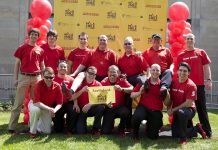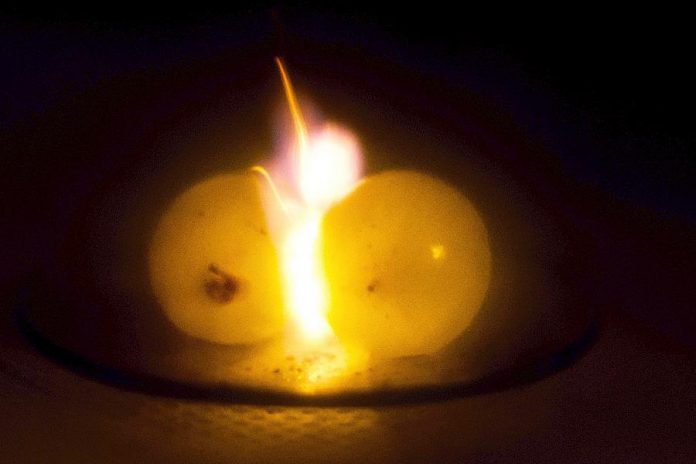
Why do two touching grapes spectacularly spark when you heat them in a microwave?
Answering that burning question might not win Trent University physicist Aaron Slepkov a Nobel Prize, but it gives him a good chance at winning the Ig Nobel Prize — awarded every autumn to celebrate 10 unusual achievements in scientific research.
Slepkov, along with co-authors Pablo Bianuccib of Concordia University and Trent undergraduate student Hamza Khattaka, published their research last month in the journal Proceedings of the National Academy of Sciences of the United States of America (PNAS) — and it immediately went viral.
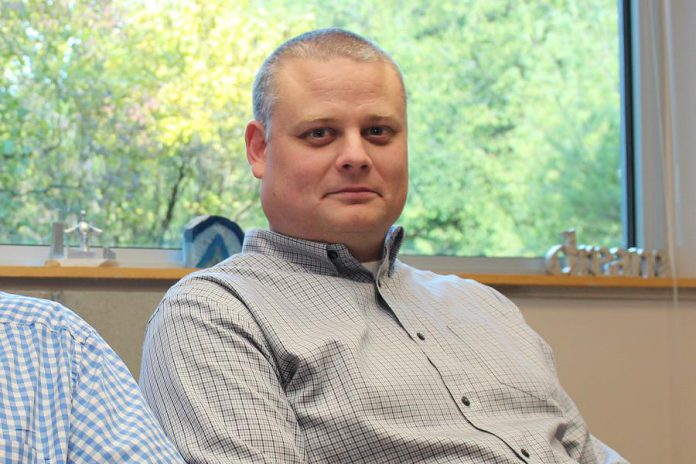
As well as being shared by everyone who has ever heated grapes in a microwave, the research has been widely covered by international media, including CBC, PBS, the Globe and Mail, the New York Times, the Smithsonian, New Scientist, Popular Mechanics, WIRED, and Cosmos, to name just a few.
Slepkov and his co-authors’ paper is entitled “Linking plasma formation in grapes to microwave resonances of aqueous dimers”. Written with a great deal of lighthearted humour, the original title was “Grape Balls of Fire”, but PNAS insisted the authors change it to something a little more science-y sounding.
So what did the researchers find out … and why does it matter?
VIDEO: Whole grapes in the microwave oven
On the face of it, heating grapes in a microwave to produce sparks is just a fun party trick. If you search on YouTube, you’ll find thousands of videos demonstrating the effect.
Slepkov first heard about it when he was an undergraduate student in the 1990s and, over the years, he would often conduct the experiment himself. After becoming faculty at Trent University, he started to research the topic in 2013 with summer intern student Aaron Curtis, and then continued the research with other undergraduate students over the years.
When you place two grapes close together in a microwave and heat them, they create a fireball of plasma (one of the four fundamental states of matter, along with solid, liquid, and gas). Plasma is an extremely hot gas of positively charged ions and negatively charged electrons (the Sun is made of plasma).
Originally, it was believed that to achieve the plasma effect with grapes, you needed to cut them in half and leave a small “bridge” of grape skin between the two halves. The common theory was that the grapes worked like an antenna, creating a current through the skin bridge that resulted in the plasma — but this was never mathematically proven.
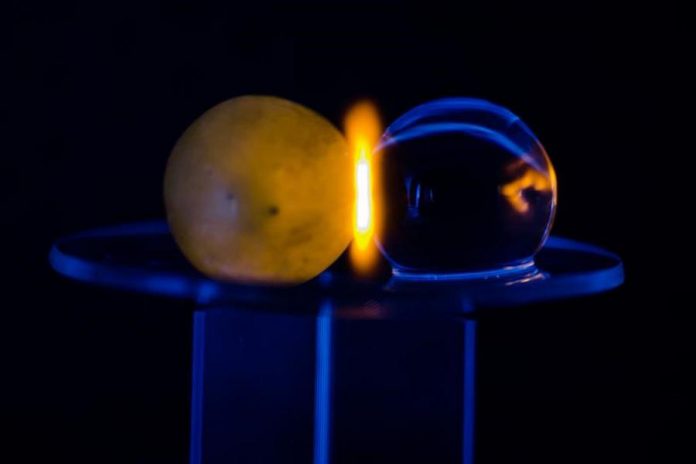
Slepkov and his co-authors have shown that the prevailing theory is not entirely correct, and have the math to back it up. Not only can you create a plasma fireball with two whole grapes touching each other, but you can create the same effect with any spherical objects of the same size that contain water. This includes large blackberries, gooseberries, quail eggs, and hydrogel beads (plastic beads containing water).
The researchers found that a grape is the same size as the wavelength of a microwave and, consisting mainly of water, has the right refractive index to trap microwaves inside it. The microwave energy becomes trapped in the centre of the grape and increases in resonance.
When two grapes are touching each other, the microwave energy in each is attracted to the other, creating an intense electrical field where the grapes intersect. Sodium and potassium molecules in the skin become ionized, freeing electrons and resulting in plasma.
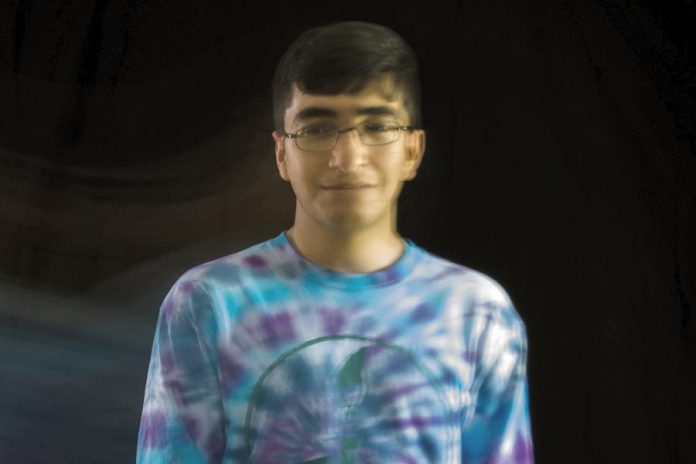
“This was such a silly project I didn’t tell anyone for the first three years because I thought I’d be laughed at,” Slepkov says in an interview with Liam Casey of The Canadian Press. “We do serious research, but it turns out there is some serious science at work here. I have students funded to microwave fruit because our gut tells us the answer will be interesting. And it is.”
The researchers went through 12 microwaves while conducting the study (operating a nearly empty microwave can damage the unit as there’s nothing to absorb the microwaves).
“Many microwaves were in fact harmed during the experiments,” co-author Hamza Khattak tells Ars Technica. “At one point, we had a microwave graveyard in the lab before disposing of the many early iterations in electronic waste.”
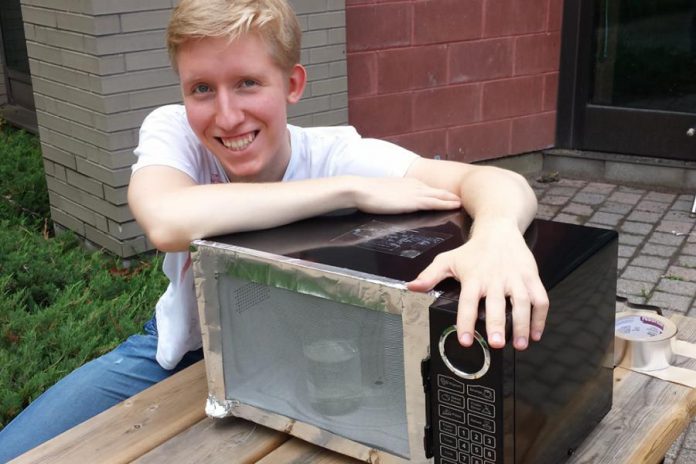
Despite the improbable topic of this research, Slepkov is a serious scientist. As well as being an associate professor in the department of physics and astronomy at Trent University, Slepkov is also the Canada Research Chair in Physics of Biomaterials and the head of the Slepkov Biophotonics Lab at Trent (or, as his undergraduate students prefer to call him, “Dear Leader”).
“We were not aimlessly playing with grapes in microwaves, but we didn’t have to hide the fact that this was really fun work,” Slepkov says.
In addition to Khattaka, Slepkov’s team included Trent University undergraduate students Emily Rose Korfanty, Rodion Gordzevich, and Alan Godfrey, as well as Aaron Curtis (now at the University of Toronto). Khattaka was included as a co-author on the paper as he was the final undergraduate student to work on the project and he helped with imaging.
VIDEO: ‘Grape Balls of Fire’: International Attention for Research by Trent Prof and Undergrad Students
While research into this topic may seem trivial at first, it actually has implications for the field of nanophotonics — the study of the behaviour of light on the nanometre scale (one billionth of a metre).
Further research could lead to better imaging technologies using microwaves (the electromagnetic radiation, not the ovens), with practical applications in medicine, space travel, the military, and maybe even your smartphone (cell phones use electromagnetic radiation in the microwave range).
“We’re hypothesizing maybe you can change antenna design because the grapes are acting as a concentrator for wireless radiation or cellphone radiation — affecting how we design antennas to help act as a signal booster,” Slepkov says in an interview with Liam Casey of The Canadian Press.






